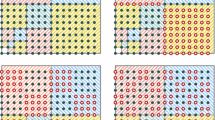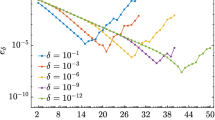Abstract
Tensor-compressed numerical solution of elliptic multiscale-diffusion and high frequency scattering problems is considered. For either problem class, solutions exhibit multiple length scales governed by the corresponding scale parameter: the scale of oscillations of the diffusion coefficient or smallest wavelength, respectively. As is well-known, this imposes a scale-resolution requirement on the number of degrees of freedom required to accurately represent the solutions in standard finite-element (FE) discretizations. Low-order FE methods are by now generally perceived unsuitable for high-frequency coefficients in diffusion problems and high wavenumbers in scattering problems. Accordingly, special techniques have been proposed instead (such as numerical homogenization, heterogeneous multiscale method, oversampling, etc.) which require, in some form, a-priori information on the microstructure of the solution. We analyze the approximation properties of tensor-formatted, conforming first-order FE methods for scale resolution in multiscale problems without a-priori information. The FE methods are based on the dynamic extraction of principal components from stiffness matrices, load and solution vectors by the quantized tensor train (QTT) decomposition. For prototypical model problems, we prove that this approach, by means of the QTT reparametrization of the FE space, allows to identify effective degrees of freedom to replace the degrees of freedom of a uniform “virtual” (i.e. never directly accessed) mesh, whose number may be prohibitively large to realize computationally. Precisely, solutions of model elliptic homogenization and high-frequency acoustic scattering problems are proved to admit QTT-structured approximations whose number of effective degrees of freedom required to reach a prescribed approximation error scales polylogarithmically with respect to the reciprocal of the target Sobolev-norm accuracy ε with only a mild dependence on the scale parameter. No a-priori information on the nature of the problems and intrinsic length scales of the solution is required in the numerical realization of the presently proposed QTT-structured approach. Although only univariate model multiscale problems are analyzed in the present paper, QTT structured algorithms are applicable also in several variables. Detailed numerical experiments confirm the theoretical bounds. As a corollary of our analysis, we prove that for the mentioned model problems, the Kolmogorov n-widths of solution sets are exponentially small for analytic data, independently of the problems’ scale parameters. That implies, in particular, the exponential convergence of reduced basis techniques which is scale-robust, i.e., independent of the scale parameter in the problem.
Similar content being viewed by others
References
Andreev, R., Tobler, C.: Multilevel preconditioning and low-rank tensor iteration for spacetime simultaneous discretizations of parabolic pdes. Numer. Linear Algebra Appl. 22(2), 317–337 (2015). doi:10.1002/nla.1951
Babuška, I.: Error-bounds for finite element method. Numer. Math. 16(4), 322–333 (1971). doi:10.1007/BF02165003
Bachmayr, M., Dahmen, W.: Adaptive low-rank methods for problems on Sobolev spaces with error control in L 2. arXiv:1412.3951. (2014)
Bakhvalov, N., Panasenko, G.: Homogenisation: Averaging processes in periodic media, Mathematics and its Applications, vol. 36. Springer. doi:10.1007/978-94-009-2247-1
Ballani, J., Grasedyck, L.: A projection method to solve linear systems in tensor format. doi:10.1002/nla.1818 (2012)
Buffa, A., Sangalli, G., Schwab, C.: Exponential convergence of the hp version of isogeometric analysis in 1D. In: Proceedings. doi:10.1007/978-3-319-01601-6_15 (2014)
Davis, P.J.: Interpolation and approximation. Dover Publications (1975)
Dolgov, S., Khoromskij, B., Oseledets, I.: Fast solution of parabolic problems in the tensor train/quantized tensor train format with initial application to the fokker–planck equation. SIAM J. Sci. Comput. 34(6), A3016–A3038 (2012). doi:10.1137/120864210
Dolgov, S.V., Kazeev, V.A., Khoromskij, B.N.: The tensor-structured solution of one-dimensional elliptic differential equations with high-dimensional parameters. Preprint 51, Max-Planck-Institut für Mathematik in den Naturwissenschaften. http://www.mis.mpg.de/publications/preprints/2012/prepr2012-51.html (2012)
Dolgov, S.V., Khoromskij, B.N.: Tensor-product approach to global time-space-parametric discretization of chemical master equation. Preprint 68, Max-Planck-Institut für Mathematik in den Naturwissenschaften. http://www.mis.mpg.de/publications/preprints/2012/prepr2012-68.html (2012)
Dolgov, S.V., Khoromskij, B.N., Oseledets, I.V., Tyrtyshnikov, E.E.: Tensor structured iterative solution of elliptic problems with jumping coefficients. Preprint 55, Max-Planck-Institut für Mathematik in den Naturwissenschaften. http://www.mis.mpg.de/publications/preprints/2010/prepr2010-55.html (2010)
Dolgov, S.V., Savostyanov, D.V.: Alternating minimal energy methods for linear systems in higher dimensions. SIAM J. Sci. Comput. 36(5), A2248–A2271 (2014). doi:10.1137/140953289
Grasedyck, L.: Hierarchical singular value decomposition of tensors. SIAM Journal on Matrix Analysis and Applications 31(4), 2029–2054 (2010). doi:10.1137/090764189. http://link.aip.org/link/?SML/31/2029/1
Grasedyck, L.: Polynomial approximation in hierarchical Tucker format by vector-tensorization. Preprint 308, Institut für Geometrie und Praktische Mathematik, RWTH Aachen. http://www.igpm.rwth-aachen.de/Download/reports/pdf/IGPM308_k.pdf (2010)
Grasedyck, L., Kressner, D., Tobler, C.: A literature survey of low-rank tensor approximation techniques. GAMM-Mitteilungen 36(1), 53–78 (2013). doi:10.1002/gamm.201310004
Hackbusch, W.: Tensor Spaces and Numerical Tensor Calculus, Springer Series in Computational Mathematics, vol. 42. Springer (2012). doi:10.1007/978-3-642-28027-6. http://www.springerlink.com/content/l62t86
Hackbusch, W., Kühn, S.: A new scheme for the tensor representation. J. Fourier Anal. Appl. 15(5), 706–722 (2009). doi:http://www.springerlink.com/content/t3747nk47m368g44, 10.1007/s00041-009-9094-9
Hoang, V.H., Schwab, C.: High-dimensional finite elements for elliptic problems with multiple scales. Multiscale Model. Simul. 3(1), 168–194 (2005). doi:10.1137/030601077
Holtz, S., Rohwedder, T., Schneider, R.: The alternating linear scheme for tensor optimization in the Tensor Train format. SIAM J. Sci. Comput. 34(2), A683–A713 (2012). doi:10.1137/100818893
Ihlenburg, F.: Finite element analysis of acoustic scattering, Applied Mathematical Sciences, vol. 132. Springer, New York (1998). doi:10.1007/b98828
Jikov, V.V., Kozlov, S.M., Oleinik, O.A.: Homogenization of Differential Operators and Integral Functionals. Springer (1994). http://www.springer.com/book/9783642846618
Kau, H.T.: An inequality for algebraic polynomials, and the dependence between the best polynomial approximations \(e(f)_{L_{p}}\) and \(e(f)_{L_{q}}\) of functions f(x)L p (in Russian). Acta Math. Acad. Sci. Hung. 27 (1-2), 141–147 (1976). doi:10.1007/BF01896769
Kazeev, V.: Quantized tensor-structured finite elements for second-order elliptic PDEs in two dimensions. Ph.D. thesis, SAM, ETH Zurich, ETH Dissertation No. 23002. doi:10.3929/ethz-a-010554062. http://e-collection.library.ethz.ch/view/eth:48314
Kazeev, V.: Tensor-structured multilevel approximation of polynomial and piecewise-analytic functions (in preparation)
Kazeev, V., Khammash, M., Nip, M., Schwab, C.: Direct solution of the chemical master equation using quantized tensor trains. PLoS Comput. Biol. 10 (3) (2014). doi:10.1371/journal.pcbi.1003359
Kazeev, V., Reichmann, O., Schwab, C.: hp-DG-QTT solution of high-dimensional degenerate diffusion equations. Research Report 11, Seminar for Applied Mathematics, ETH Zürich. http://www.sam.math.ethz.ch/reports/2012/11 (2012)
Kazeev, V., Reichmann, O., Schwab, C.: Low-rank tensor structure of linear diffusion operators in the TT and QTT formats. Linear Algebra Appl. (2013). doi:10.1016/j.laa.2013.01.009
Kazeev, V., Schwab, C.: Approximation of singularities by quantized-tensor FEM. In: Proceedings in Applied Mathematics and Mechanics. doi:10.1002/pamm.201510353, vol. 15, pp 743–746 (2015)
Kazeev, V., Schwab, C.: Quantized tensor-structured finite elements for second-order elliptic PDEs in two dimensions. Research Report 24, Seminar for Applied Mathematics, ETH Zürich. http://www.sam.math.ethz.ch/reports/2015/24 (2015)
Kazeev, V., Schwab, C.: Tensor approximation of stationary distributions of chemical reaction networks. SIAM J. Matrix Anal. Appl. 36(3), 1221–1247 (2015). doi:10.1137/130927218
Kazeev, V.A., Khoromskij, B.N.: Low-rank explicit QTT representation of the Laplace operator and its inverse. SIAM J. Matrix Anal. Appl. 33(3), 742–758 (2012). doi:10.1137/100820479
Kazeev, V.A., Khoromskij, B.N., Tyrtyshnikov, E.E.: Multilevel Toeplitz matrices generated by tensor-structured vectors and convolution with logarithmic complexity. SIAM J. Sci. Comput. (2013)
Khoromskij, B.N.: \(\mathcal {O}(d n)\)-quantics approximation of n-d tensors in high-dimensional numerical modeling. Constr. Approx. 34(2), 257–280 (2011). doi:10.1007/s00365-011-9131-1
Khoromskij, B.N., Khoromskaia, V., Flad, H.J.: Numerical solution of the Hartre-Fock equation in multilevel tensor-structured format. SIAM J. Sci. Comput. 33(1), 45–65 (2011). doi:10.1137/090777372. http://link.aip.org/link/?SCE/33/45/1
Khoromskij, B.N., Oseledets, I.V.: A fast iteration method for solving elliptic problems with quasiperiodic coefficients. Russ. J. Numer. Anal. Math. Model. 30(6), 329–344 (2015). doi:10.1515/rnam-2015-0030. http://www.degruyter.com/view/j/rnam.2015.30.issue-6/rnam-2015-0030/rnam-2015-0030.xml
Khoromskij, B.N., Schwab, C.: Tensor-structured Galerkin approximation of parametric and stochastic elliptic PDEs. SIAM J. Sci. Comput. 33(1), 364–385 (2011). http://epubs.siam.org/sisc/resource/1/sjoce3/v33/i1/p364_s1
Kressner, D., Steinlechner, M., Uschmajew, A.: Low-rank tensor methods with subspace correction for symmetric eigenvalue problems. Technical report 40, MATHICSE EPFL. http://sma.epfl.ch/~anchpcommon/publications/EVAMEN.pdf (2013)
Kressner, D., Steinlechner, M., Vandereycken, B.: A fast iteration method for solving elliptic problems with quasiperiodic coefficients. arXiv:1508.02988 (2015)
Maday, Y., Mula, O., Turinici, G.: Convergence analysis of the generalized empirical interpolation method. Tech. rep., HAL-UPMC. http://hal.upmc.fr/file/index/docid/1032458/filename/maday_mula_turinici_ConvRates_SINUM_Submitted.pdf
Nessel, R.J., Wilmes, G.: Nikolskii-type inequalities for trigonometric polynomials and entire functions of exponential type. J. Aust. Math. Soc. Ser. A 25, 7–18 (1978). doi:10.1017/S1446788700038878
Oseledets, I.: Approximation of matrices with logarithmic number of parameters. Dokl. Math. 80, 653–654 (2009). doi:10.1134/S1064562409050056
Oseledets, I., Dolgov, S.: Solution of linear systems and matrix inversion in the TT-format. SIAM J. Sci. Comput. 34(5), A2718–A2739 (2012). doi:10.1137/110833142
Oseledets, I.V.: Approximation of 2d2d matrices using tensor decomposition. SIAM J. Matrix Anal. Appl. 31(4), 2130–2145 (2010). doi:10.1137/090757861. http://link.aip.org/link/?SML/31/2130/1
Oseledets, I.V.: Tensor train decomposition. SIAM J. Sci. Comput. 33(5), 2295–2317 (2011). doi:10.1137/090752286
Oseledets, I.V.: Constructive representation of functions in tensor formats. Constr. Approx. 37, 1–18 (2013). http://link.springer.com/article/10.1007/s00365-012-9175-x
Oseledets, I.V., Tyrtyshnikov, E.E.: Breaking the curse of dimensionality, or how to use SVD in many dimensions. SIAM J. Sci. Comput. 31(5), 3744–3759 (2009). doi:10.1137/090748330. http://epubs.siam.org/sisc/resource/1/sjoce3/v31/i5/p3744_s1
Pinkus, A.: n-widths in approximation theory, Ergebnisse der Mathematik und ihrer Grenzgebiete (3) [Results in Mathematics and Related Areas (3)], vol. 7. Springer, Berlin (1985). doi:10.1007/978-3-642-69894-1
Quarteroni, A., Manzoni, A., Negri, F.: Reduced Basis Methods for Partial Differential Equations, UNITEXT, vol. 92. Springer (2016). http://link.springer.com/book/10.1007/978-3-319-15431-2
Schwab, C.: P- and H p-FEM: Theory and Application to Solid and Fluid Mechanics. Oxford University Press, Oxford (1998)
Tyrtyshnikov, E.E.: Tensor approximations of matrices generated by asymptotically smooth functions. Sbornik: Math. 194 (5), 941–954 (2003). doi:10.1070/SM2003v194n06ABEH000747. http://iopscience.iop.org/1064-5616/194/6/A09
Beirão da Veiga, L., Buffa, A., Rivas, J., Sangalli, G.: Some estimates for hpk-refinement in isogeometric analysis. Numer. Math. 118(2), 271–305 (2011). doi:10.1007/s00211-010-0338-z
Verstraete, F., Porras, D., Cirac, J.I.: Density matrix renormalization group and periodic boundary conditions: A quantum information perspective. Phys. Rev. Lett. 93(22), 227,205 (2004). doi:10.1103/PhysRevLett.93.227205
Vidal, G.: Efficient classical simulation of slightly entangled quantum computations. Phys. Rev. Lett. 91(14), 147,902 (2003). doi:10.1103/PhysRevLett.91.147902
White, S.R.: Density-matrix algorithms for quantum renormalization groups. Phys. Rev. B 48(14), 10,345–10,356 (1993). doi:10.1103/PhysRevB.48.10345
Author information
Authors and Affiliations
Corresponding author
Additional information
Communicated by: Karsten Urban
CS was supported by the European Research Council through the FP7 Advanced Grant AdG247277. The research of VK was performed at the Seminar for Applied Mathematics, ETH Zurich. IO and MR were supported by the Ministry of Education and Science of Russian Federation, Grant Agreement no. 14.618.21.0004, the unique project identifier RFMEFI61815X0004.
Rights and permissions
About this article
Cite this article
Kazeev, V., Oseledets, I., Rakhuba, M. et al. QTT-finite-element approximation for multiscale problems I: model problems in one dimension. Adv Comput Math 43, 411–442 (2017). https://doi.org/10.1007/s10444-016-9491-y
Received:
Accepted:
Published:
Issue Date:
DOI: https://doi.org/10.1007/s10444-016-9491-y
Keywords
- Multiscale problems
- Helmholtz equation
- Homogenization
- Scale resolution
- Exponential convergence
- Tensor decompositions
- Quantized tensor trains




